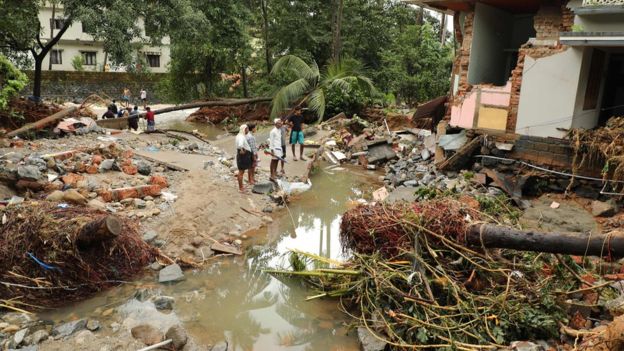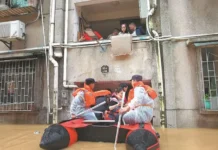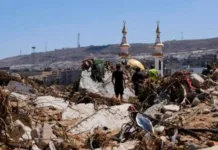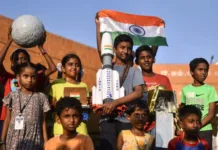
At least 324 people have been killed in flooding in the southern Indian state of Kerala in what local officials say is the worst flooding in 100 years.
India’s monsoon season started in June, but the death toll in Kerala has soared in the last 24 hours.
Rescuers are battling torrential rains to save residents, with more than 200,000 people left homeless in camps.
The state government said many of those who died were crushed under debris caused by landslides.
With more rains predicted and a red alert in place, Kerala’s main airport is expected to remain shut until 26 August.
Hundreds of troops have been deployed to rescue those caught up in the flooding.
Helicopters have been airlifting people marooned by the flooding to safety, with photographs and footage emerging from the area showing elderly people and children being rescued.
More than 300 boats are also involved in rescue attempts, AFP news agency reports.
The government has urged people not to ignore evacuation orders, and is distributing food to tens of thousands who have fled to higher ground.
The Indian home ministry says more than 930 people have now died across India since the country’s monsoon season began.
How bad is the Kerala flooding?
The region’s chief minister Pinarayi Vijayan has described the flooding as the worst the state has seen in a century.
“We’re witnessing something that has never happened before in the history of Kerala,” he told reporters.
Mr Vijayan said more than 223,000 people were now living in the more than 1,500 emergency relief camps set up in the area.
Parts of Kerala’s commercial capital, Cochin, are underwater, snaring up roads and leaving railways across the state impassable.
The state’s airport is a hub for domestic and overseas tourists, so its closure is likely to cause major disruption.
Some local plantations are reported to have been inundated by water, endangering the local rubber, tea, coffee and spice industries.
Schools in all 14 districts of Kerala have been closed and some districts have banned tourists, citing safety concerns.
What is the government doing?
India’s Prime Minister Narendra Modi was set to visit the region on Friday night.
The country’s home minister has also offered his support.
Anil Vasudevan, the head of the Kerala health disaster response wing, has said they are prepared to help victims and are setting arrangements in place to deal with the potential risks of water-borne diseases when the flooding recedes.
Why is the situation so bad?
It is normal for Kerala to get some of the country’s highest rainfall during monsoon season, but the India Meteorological Department said it had been hit with 37% more than usual because of a spell of low pressure over the region.
Further downpours are forecast for the weekend, leading many to fear the situation may get worse.
Environmental scientists are also blaming deforestation, especially the failure to protect ecologically fragile mountain ranges in the area, local media report.
Mr Vijayan, the region’s chief minister, has said the situation in Kerala has been made worse by neighbouring governments.
Earlier this week, he and his counterpart in Tamil Nadu entered a public spat over the release of water from a dam.
Kerala has 41 rivers flowing into the Arabian Sea, and 80 of its dams are now said to be open after being overwhelmed.
“Almost all dams are now opened. Most of our water treatment plants are submerged. Motors are damaged,” Mr Vjayan said.
‘Neck-deep water’
BBC Tamil’s Pramila Krishnan spoke to several people who had escaped the flooding in Cochin.
Krishna Jayan, 58, said she was at home sleeping when her friend woke her up.
“I opened the door and water gushed in,” she said. “When we stepped into the street, we were neck-deep in water.”
She said locals had tied ropes along the streets to help people walk through the water, allowing her and her friend to reach a bus to escape.
Another resident, 33-year-old Shabbir Saheel, said he had to carry his two-year-old daughter on his shoulders through the flooded streets to safety.
Source: BBC




